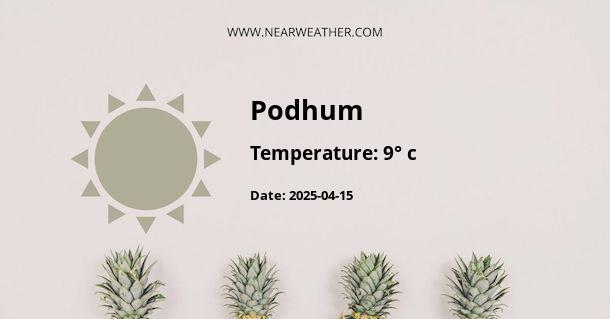Understanding the Climate and Weather of Podhum, Bosnia and Herzegovina
The picturesque location of Podhum in Bosnia and Herzegovina (BA) provides a rich tapestry for weather enthusiasts and travelers alike, presenting a climate that is characteristic of the broader region with unique local nuances. Nestled within the Balkans, Podhum's weather pattern is profoundly influenced by its geographic position and topography, leading to distinct seasonal variations that offer different colors of nature for each part of the year.
Geographic and Climatic Overview
Before delving into the month-by-month weather patterns, it's imperative to comprehend the overarching climatic backdrop of Podhum. The area lies within a temperate continental climate zone with Mediterranean influences due to its proximity to the Adriatic Sea. This amalgam leads to hot summers and cold, snowy winters, with transitional spring and autumn seasons.
Seasonal Weather Patterns
Podhum's climate is divided into four distinct seasons, each with its charm and challenges. The weather oscillates between the warmth of the Mediterranean breezes and the crispness of the continental mountainous airs.
Winter (December to February)
In the winter months, Podhum's proximity to the Dinaric Alps plays a critical role in its weather conditions. Temperatures often drop below the freezing point, and snowfall is a common occurrence. The following table encapsulates the average winter temperatures and precipitation levels:
| Month | Average High Temperature (°C) | Average Low Temperature (°C) | Average Precipitation (mm) |
|---|---|---|---|
| December | 3 | -3 | 80 |
| January | 2 | -4 | 70 |
| February | 5 | -2 | 65 |
Spring (March to May)
Spring ushers in a noticeable warming trend, with longer daylight hours and a gradual increase in temperature. Precipitation levels start to rise as the snow melts and contributes to the region’s lushness.
- March: The chill of winter begins to dissipate, with an average high of 10°C and low of 1°C. Rainfall averages around 70 mm.
- April: Temperatures continue to climb, with an average high of 16°C and low of 5°C. Precipitation sees a slight uptick to 75 mm.
- May: Spring is in full swing and temperatures average between 21°C and 9°C. However, this month can experience higher rainfall, averaging 85 mm.
Summer (June to August)
The Mediterranean influence becomes more pronounced in the summer, leading to hot, dry weather, particularly in July and August. Below is the summary of summer weather statistics in Podhum:
| Month | Average High Temperature (°C) | Average Low Temperature (°C) | Average Precipitation (mm) |
|---|---|---|---|
| June | 25 | 13 | 90 |
| July | 28 | 15 | 70 |
| August | 28 | 15 | 60 |
Autumn (September to November)
Autumn brings a kaleidoscope of colors to Podhum as the leaves change. The temperatures gradually cool down, and the weather systems become more unstable, leading to increased precipitation, especially in November.
- September: The weather remains warm with average highs of 24°C and lows of 11°C, with around 100 mm of precipitation.
- October: A more pronounced cooling trend begins, with temperatures ranging from 17°C to 7°C on average, and precipitation levels at 120 mm.
- November: The first signs of winter start showing, with temperatures dropping to an average high of 10°C and lows around 3°C. The average rainfall is about 140 mm, the highest of the season.
Microclimates of Podhum
It is essential to highlight that due to the region’s varied topography, microclimates can significantly impact local weather patterns. As such, variations in elevation, proximity to bodies of water, and other geographical features can alter the general climate synopsis provided earlier.
Microclimates in Podhum can cause divergent weather patterns within a relatively small area. This phenomenon is due to the complex interactions between the unique physical geography of the area and the overarching climatic influences.
Extreme Weather and Climate Tendencies
While the aforementioned seasonal descriptions serve as a general guideline, Podhum is no stranger to extreme weather events. The region is susceptible to strong winds, particularly the Bora wind, which can significantly affect winter temperatures and lead to sharper cold spells. Additionally, summer heatwaves brought on by the North African air masses can result in significantly higher temperatures than the season averages.
Expert Opinions and Research on Climate Change
The impact of climate change on the weather patterns in Podhum, as in the rest of the world, is becoming an undeniable factor. Recent studies point to an increase in temperature averages and changes in precipitation patterns. For example, experts predict:
- An upward trend in average temperatures year-round, possibly leading to longer and more intense heatwaves during the summer.
- Variability in precipitation, with an increased likelihood of extreme events like heavy rainstorms and droughts.
- A decrease in snowfall and a shorter winter season, which can impact the local ecosystems and water supply.
International research teams, such as those under the Intergovernmental Panel on Climate Change (IPCC), emphasize the need for localized climate studies to adapt to these new challenges and mitigate potential adverse impacts.
Final Remarks on Podhum's Climate
In conclusion, Podhum, Bosnia and Herzegovina, enjoys a diverse climate with clear seasonal delineations, each offering its own range of weather patterns. From the snow-clad winters to the sun-soaked summers, the region's climate is as dynamic as it is beautiful. Understanding these patterns not only helps residents and visitors prepare for their time in Podhum but also provides valuable insights into the broader discussions on climate variability and change.
A - Podhum's Latitude is 43.723061 & Longitude is 17.001110.
A - Weather in Podhum is 9° today.
A - Climate Conditions in Podhum shows moderate rain today.
A - Humidity in Podhum is 90% today.
A - Wind speed in Podhum is 21.42 km/h, flowing at 139° wind direction. today.
